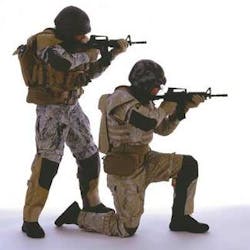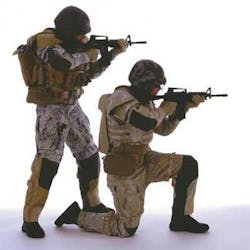Army to spin off future soldier gear to homeland security first responders
By Ben Ames
NATICK, Mass. — U.S. military forces in Iraq had an enormous technology advantage over Saddam Hussein's vaunted Republican Guard, from nutrition and textiles to communications and weaponry.
The 21st century war-fighting gear that helped coalition forces prevail over Saddam Hussein's regime could soon help domestic emergency workers handle terrorist attacks by advantage of battlefield clothing and protection.
This is according to Rita Gonzalez, director of the National Protection Center at the U.S. Army Natick Soldier Center in Natick, Mass. She spoke at the Homeland Security Solutions Conference in Baltimore in April.
null
Imagine a lightweight suit of protective clothing that not only protects emergency responders from nuclear, biological, and chemical (NBC) threats, but also provides self-decontamination, microclimate conditioning, improved C4I (command, control, communications, computers, and intelligence), GPS navigation, and biometric monitors.
Engineers at the Natick Soldier Center are designing military uniforms that do all that and more, Gonzalez says. They will not see action until 2009 at the soonest, though first responders may see them sooner. That is because first responders have different requirements than soldiers, and have less money to pay for the gear.
One challenge they share is weight. Technology can make materials lighter, but also adds extra equipment (no one carried GPS units 20 years ago). "We've always treated soldiers like Christmas trees," Gonzalez says. "If you put a hundred one-pound pieces of equipment on his belt, it still weighs a hundred pounds."
Another shared requirement could be chemical and biological attacks. Soldiers in a contaminated battlefield might have to keep their suits sealed for three to five days, which makes it tough to eat, drink, and handle human waste. One possible solution is an adhesive patch that provides nutrition, similar to the drug-release patches worn by people trying to quit smoking.
Whether soldiers or firefighters wear such a suit, the key is integrating every function with the others. Every piece of gear must be modular and interoperable, or plug-and-play, Gonzalez says. "You have to treat the human as a system. You can't add anything extra without fitting it into that entire system."
The evolution of soldiers' clothing is part of Army Transformation, the Pentagon's evolution of the U.S. military from an approach of overwhelming force to be smaller, quicker, more accurate, and lethal. It begins with Legacy Force, which includes all current equipment. The next step is Interim Force, aka "Land Warrior," and the final goal is the Objective Force Warrior (OFW).
The OFW is a self-contained, networked combat suit that enables a soldier to carry his basic gear as well as body armor, load-carrying assistance, remote triage like automated drug treatment and tourniquets, and protection from chemical and biological agents. Engineers at Natick plan to demonstrate OFW Phase I by 2006 and Phase II by 2011.
First responders may get to use parts of that technology even sooner. The military version of the full suits will be too specialized for domestic use, but the helmets will be nearly identical, so police officers and firefighters may be wearing OFW helmets within two years, Gonzalez says. For either soldiers or emergency workers, the helmet must provide interoperable communications, situational awareness, sensor fusion, biometrics, and network linkage, as well as ballistic, impact, and environmental protection.
In fact, three projects are close to producing usable equipment today. In the first project, Army clothing designers are teaming with firefighters to create a next-generation suit.
Designers displayed a prototype last year at the International Association of Fire Fighters' biannual convention in Las Vegas. The Law Enforcement/Corrections Tactical Uniform System borrows technology from the Objective Force Warrior, such as physiological status monitoring, and the Scorpion helmet, which contains an illuminator, radio antenna, and global positioning system.
In the second project, Army designers also are working with firefighters to create safe breathing standards for respiratory protection from chemical and biological toxins. The project involves the National Fire Protection Association, the National Institute for Occupational Safety and Health, the National Institute for Justice, and the National Institute for Standards and Technology.
The third project has the Army working with a team from Oklahoma State University in Stillwater, Okla., to create a wearable cooling system for NBC protective suits. The in-suit air conditioning system uses a battery-powered, liquid circulator capable of dissipating 200 watts of body heat in an 80-degreee environment.
To share other types of gear, the Natick Soldier Center has an office dedicated to finding civilian applications for military technology. Read more about the National Protection Center on the World Wide Web at http://www.natick.army.mil/soldier/NPC.
Likewise, the U.S. Department of Justice has a non-profit branch that finds commercial uses for law enforcement gear. Read more about the Office of Law Enforcement Technology Commercialization on the Web at http://www.oletc.org/.
The Emergency Response Technology (ERT) Program is a division of the National Technology Transfer Center (NTTC), located at Wheeling Jesuit University in Wheeling, W.Va. ERT commercializes health and safety products for emergency responders. See http://www.nttc.edu/ertprogram/ for more information.

